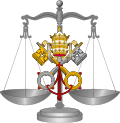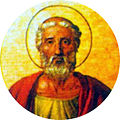 |
| Part of a series on the |
| Canon law of the Catholic Church |
|---|
| |
A papal renunciation (Latin : renuntiatio), also called a papal abdication, occurs when the current pope of the Catholic Church voluntarily resigns his position. As a pope conventionally holds the office for life, a papal renunciation is an uncommon event. Before the 21st century, only five popes unambiguously resigned with historical certainty, all between the 10th and 15th centuries. There are disputed claims of four popes having resigned, dating from the 3rd to the 11th centuries; a fifth disputed case may have involved an antipope.
Contents
- Modern procedure
- History
- 11th century
- Celestine V
- Western Schism
- Benedict XVI
- List of papal renunciations
- Conditional renunciations not put into effect
- Incapacitation
- See also
- References
- Works cited
Additionally, a few popes during the saeculum obscurum were "deposed", meaning driven from office by force. The history and canonical question here is complicated; generally, the official Vatican list of popes seems to recognize such "depositions" as valid renunciations if the pope acquiesced, but not if he did not. The later development of canon law has been in favor of papal supremacy, leaving no recourse to the removal of a pope involuntarily. [1]
The most recent pope to resign was Benedict XVI, who vacated the Holy See on 28 February 2013, the date of his effective resignation. He was the first pope to do so since Gregory XII in 1415.
Despite its common usage in discussion of papal renunciations, [2] the term abdication is not used in the official documents of the church for renunciation by a pope.










